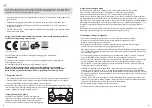
3
4
4. Adjustment of the straps
When wearing the helmet for the first time, please adjust the straps so that they meet
tautly and comfortably beneath the ears.
The easily adjustable triangular locks (fig. 1 + 2) on both sides, with their optional fastener
(fig. 1) help you in doing so.
The child proof lock must be engaged properly, before first use, with an audible “click” to
prevent accidental displacement.
Make sure the chin-guard, which must be locked before every ride, doesn’t lie on the
jaw-bone (fig. 3 – 5).
After adjustment, the overlapping straps can be secured with the strap clip (fig. 6).
Should the straps be too long, please cut them down to the required length and seal the
ends with a match flame to prevent fraying.
5. Proper maintenance and care
• Regularly check the helmet for signs of damage.
• Do not alter the specification of this helmet as it will reduce its protective effect.
• Do not apply stickers or paint to the helmet as this can be damaging to the materials.
• Do not remodel or misuse the helmet.
• Do not expose the helmet to temperatures in excess of 60˚C. Do not store behind glass,
e.g. in a car (burning glass effect), near heaters etc.
• If you suspect that the helmet has received a large impact, even if there is no visible
damage, please purchase a new helmet.
• This helmet has a limited service life and should be replaced when it shows obvious
signs of wear.
• Depending on the frequency of use and the specific operational conditions, a bicycle
helmet must be replaced 4 - 5 years after the first time it is used. In view of the unavoi-
dable material fatigue, the helmet must, however, be replaced at most 8 years after its
production date even if it displays no clear visible or technical defects.
• The helmet, inner pads and head ring can be cleaned using lukewarm water,
solvent-free detergents and a soft cloth.
• Only use original spare parts.
• Please contact your local waste disposal company for correct disposal.
Congratulations! You are now the owner of a top quality ABUS bicycle helmet. This
helmet has been produced under strict conditions and is certified according to the
following standards:
• The helmet is classed as Category II PPE and conforms with Regulation (EU) 2016/425.
• The full declaration of conformity can be found at https://docs.abus.com/
• Testhaus TÜV Rheinland LGA Products GmbH, N.B. 0197, Tillystrasse 2, D-90431 Nürnberg.
• EN 1078:2012+A1:2012 – European standard for cyclists, skateboarders and inline skaters.
Attention: Please note that no helmet is indestructible and will not prevent all
head injuries.
For the best possible protection, please observe the following guidelines:
1. Usage
This helmet is recommended as protective equipment for the following activities (fig. A).
It is not suitable for the following activities (fig. B).
Attention: Please note that it is necessary for children to remove their helmets before
entering playgrounds. This helmet should not be used by children while climbing or
doing other activities when there is a risk of strangulation/hanging if the child gets
trapped with the helmet.
2. Optimum fit
• Please try various sizes for comfort and security, ensuring that the helmet sits
horizontally on your head.
• Do not pull the helmet over your forehead, reducing visibility.
• Do not push the helmet towards the back of your head, as this will not protect
your forehead.
The helmet can only protect your head if it fits correctly (fig. C).
3. Adjustement of the head ring
Almost all ABUS helmets are available in 2 sizes.
Adjusting the helmet to the individual head size
can be achieved, depending on the type, with the
following easy to use fitting systems.
EN 1078:2012+A1:2012
Содержание 40371
Страница 18: ...33 34 ...




































